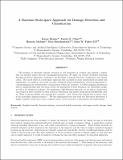Notice
This is not the latest version of this item. The latest version can be found at:https://dspace.mit.edu/handle/1721.1/134487.2
A Bayesian state-space approach for damage detection and classification
Author(s)
Dzunic, Zoran; Chen, Justin G; Mobahi, Hossein; Büyüköztürk, Oral; Fisher, John W
DownloadAccepted version (4.942Mb)
Terms of use
Metadata
Show full item recordAbstract
© 2017 Elsevier Ltd The problem of automatic damage detection in civil structures is complex and requires a system that can interpret collected sensor data into meaningful information. We apply our recently developed switching Bayesian model for dependency analysis to the problems of damage detection and classification. The model relies on a state-space approach that accounts for noisy measurement processes and missing data, which also infers the statistical temporal dependency between measurement locations signifying the potential flow of information within the structure. A Gibbs sampling algorithm is used to simultaneously infer the latent states, parameters of the state dynamics, the dependence graph, and any changes in behavior. By employing a fully Bayesian approach, we are able to characterize uncertainty in these variables via their posterior distribution and provide probabilistic estimates of the occurrence of damage or a specific damage scenario. We also implement a single class classification method which is more realistic for most real world situations where training data for a damaged structure is not available. We demonstrate the methodology with experimental test data from a laboratory model structure and accelerometer data from a real world structure during different environmental and excitation conditions.
Date issued
2017Journal
Mechanical Systems and Signal Processing
Publisher
Elsevier BV